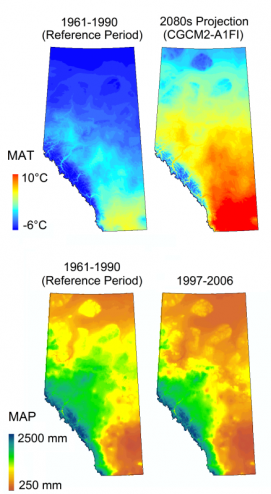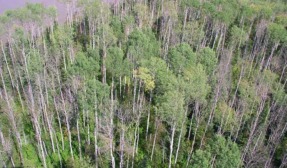6. Adaptation and climate change

Given that climate conditions are a major selective force that results in physiological and morphological adaptation of tree population to local climate, global climate change is a major concern. If climate change projections are correct, we will see sub-optimal productivity and mal-adapted forests throughout Alberta in the near future. Over the past two decades, Alberta has experienced a warming trend of approximately 0.7°C in mean annual temperature (MAT) that matches or exceeds predictions from global circulation models. Those models also predict 3-5°C warming by the end of the century (figure top right). Over the past 20 years, we have also seen a pronounced trend towards drier condition with up to 25% less precipitation in central Alberta than two decades ago (figure bottom right).
On one hand, there may be reason for optimism. Forest productivity of boreal and sub-boreal ecosystems should increase considerably under moderate warming (1-2°C) due to an extended growing season, resulting in economic gains that match or exceed genetic gains from tree improvement efforts. On the other hand, temperature increases in the order of 3-5°C in combination with drier conditions will likely have negative consequences. Exceptional drought conditions in 2001 and 2002 have already caused dieback in aspen (photo below) and white spruce stands in central Alberta and generally reduced forest productivity during these years throughout the province.
On one hand, there may be reason for optimism. Forest productivity of boreal and sub-boreal ecosystems should increase considerably under moderate warming (1-2°C) due to an extended growing season, resulting in economic gains that match or exceed genetic gains from tree improvement efforts. On the other hand, temperature increases in the order of 3-5°C in combination with drier conditions will likely have negative consequences. Exceptional drought conditions in 2001 and 2002 have already caused dieback in aspen (photo below) and white spruce stands in central Alberta and generally reduced forest productivity during these years throughout the province.

Revising seed zones and controlled parentage program regions to match planting stock to new climate realities will become an important tool in the future to maintain forest healthy and productivity in the province. Data from our provenance trial programs that allow us to understand how species are adapted to various climatic factors will be crucial in meeting this challenge.